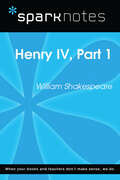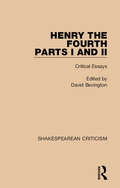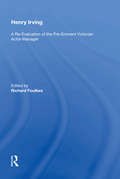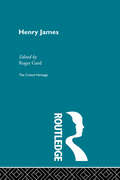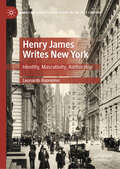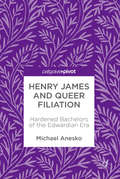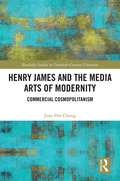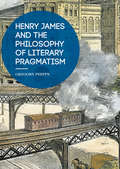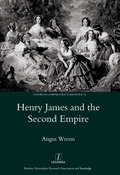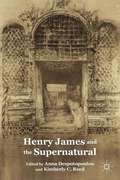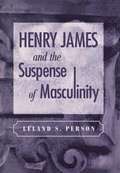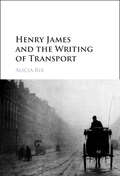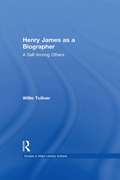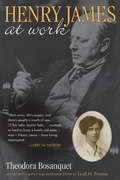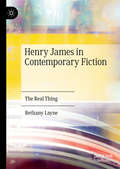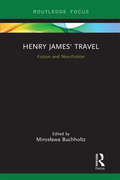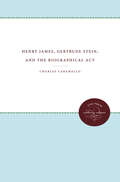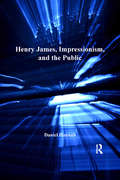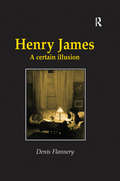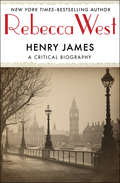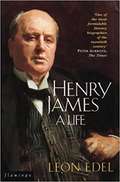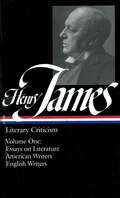- Table View
- List View
Henry IV, Part I (SparkNotes Literature Guide Series)
by SparkNotesHenry IV, Part I (SparkNotes Literature Guide) by William Shakespeare Making the reading experience fun! Created by Harvard students for students everywhere, SparkNotes is a new breed of study guide: smarter, better, faster.Geared to what today's students need to know, SparkNotes provides:chapter-by-chapter analysis explanations of key themes, motifs, and symbols a review quiz and essay topics Lively and accessible, these guides are perfect for late-night studying and writing papers.
Henry IV, Parts I and II: Critical Essays (Shakespearean Criticism)
by David BevingtonOriginally published in 1986. This volume points to the rich variety of critical responses to the Henry IV plays and their complexity. It includes selections from characteristic thought of the neoclassical age, character criticism in the eighteenth and nineteenth centuries, historical and new criticism, theatrical interpretation and other pieces by the likes of Samuel Johnson and W. H. Auden. The editor’s introduction explains the collection’s relevance and puts the pieces in context. Several chapters look at the character of Falstaff and the changing response and critique through time. Organised chronologically, the collection then ends with two pieces of theatrical criticism.
Henry Irving: A Re-Evaluation of the Pre-Eminent Victorian Actor-Manager (Routledge Library Editions: The Victorian World Ser. #18)
by Richard FoulkesHenry Irving (1838-1905), the first actor to be knighted, dominated the theatre in Britain and beyond for over a quarter of a century. As an actor, he was strikingly different with his idiosyncratic pronunciation, his somewhat ungainly physique, and his brilliant psychological portrayals of virtue and villainy. As a director of spectacular, and commercially driven, entertainments, Irving anticipated Hollywood directors from D.W. Griffith to Stephen Spielberg. And as manager of the Lyceum Theatre, where audiences included the leading public figures of the day, he controlled every aspect of the performance. This collection of essays by leading theatre scholars explores each element of Irving's art: his acting, his contribution to the plays he commissioned, his flair for the stage picture, and his ear for incidental music. Like Wagner, Irving was a proponent of a holistic approach to the stage, that is, blending together acting, painting, music, and architecture to create harmonious, balanced, and artistic theatre. Irving emerges not only as the peer of such eminent contemporaries as Tennyson, Sullivan, Shaw, and Burne-Jones, but also as a powerful influence on the twentieth-century theatre.
Henry James (Critical Heritage Ser.)
by Roger GardThis set comprises 40 volumes covering 19th and 20th century European and American authors. These volumes will be available as a complete set, mini boxed sets (by theme) or as individual volumes. This second set complements the first 68 volume set of Critical Heritage published by Routledge in October 1995.
Henry James Writes New York: Identity, Masculinity, Authorship (American Literature Readings in the 21st Century)
by Leonardo BuonomoThis book offers the first full-length study of Henry James's relationship with, and literary treatment of, New York. It shows how the city, whether observed or reimagined, always remained an essential component of James's identity. New York compelled James to confront both his status as an American-born male artist and his age's prevailing notions of gender, sexuality, class, citizenship, and success. Tracing James's attachment to the city and how it evolved during his lifetime, this book examines a wide range of James's works, from his short stories and novels to his non-fiction writing.
Henry James and Queer Filiation: Hardened Bachelors Of The Edwardian Era
by Michael AneskoThis study challenges the notion that closeted secrecy was a necessary part of social life for gay men living in the shadow of the trial and imprisonment of Oscar Wilde. It reconstructs a surprisingly open network of queer filiation in which Henry James occupied a central place. The lives of its satellite figures — most now forgotten or unknown — offer even more suggestive evidence of some of the countervailing forms of social practice that could survive even in that hostile era. If these men enjoyed such exemption largely because of the prerogatives of class privilege, their relative freedom was nevertheless a visible rebuke to the reductive stereotypes of homosexuality that circulated and were reinforced in the culture of the period. This book will be of particular interest to scholars of Henry James and queer studies, readers of late Victorian and modern literature, and those interested in the history and social construction of gender roles.
Henry James and the Culture of Consumption
by Miranda El-RayessThis book explores Henry James's imaginative engagements with the burgeoning consumer culture of the late nineteenth and early twentieth centuries, focusing on his hitherto neglected fascination with shops and the shopping experience. Examining a wide range of the author's fiction and non-fiction in the context of developments such as the rise of the department store, the growing public presence of women shoppers and shop workers, and the increasing sophistication of commodity display and advertising, the book argues that consumer desire constitutes an integral part of James's understanding of modern subjectivity. It also demonstrates that the structures and strategies of commodity culture are deeply embedded in his style, his aesthetic and his conception of authorship. The study offers new readings of familiar and less familiar texts, and includes a wealth of original historical documentation that has been gleaned from contemporary newspapers, periodicals, advertising manuals, sales catalogues and guidebooks.
Henry James and the Media Arts of Modernity: Commercial Cosmopolitanism (Routledge Studies in Twentieth-Century Literature)
by June Hee ChungHenry James and the Media Arts of Modernity: Commercial Cosmopolitanism turns to the author’s late fiction, letters, and essays to investigate his contribution to the development of an American cosmopolitan culture, both in popular and high art. The book contextualizes James’s writing within a broader cultural and social history to uncover relationships among increasingly sensory-focused media technologies, mass-consumer practices, and developments in literary style when they spread to Europe at the inception of the era of big business. Combining cultural studies with neoclassical Marxism and postcolonial theory, the study addresses a gap in scholarship concerning the rise of literary modernism as a cosmopolitan phenomenon. Although scholars have traditionally acknowledged the international character of artists’ participation in this movement, when analyzing the contributions of American expatriate writers in Europe, they generally assume an unequal degree of reciprocity in transatlantic cultural exchange with European artists being more influential than American ones. This book argues that James identifies a cultural form of American imperialism that emerged out of a commercialized version of cosmopolitanism. Yet the author appropriates the arts of modernity when he realizes that art generated with the mechanized principles of mass-production spurred a diverse range of aesthetic responses to other early-twentieth century technological and organizational innovations.
Henry James and the Philosophy of Literary Pragmatism
by Gregory PhippsThis book examines the interdisciplinary foundations of pragmatismfrom a literary perspective, tracing the characters and settings that populatethe narratives of pragmatist thought in Henry James's work. Cultivated during apostwar era of industrial change and economic growth, pragmatism emerged in thelate nineteenth century as the new shape of American intellectual identity. Charles Peirce, William James, and Oliver Wendell Holmes, Jr. were closefriends who founded different branches of pragmatism while writing on a vastarray of topics. Skeptical about philosophy, William James's brother, Henry,stood at the margins of this group, crafting his own version of pragmatism throughhis novels and short stories. Gregory Phipps argues that James's fiction weavestogether the varied depictions of individuality, society, experience, and truthfound in the works of Peirce, Holmes, and William James. By doing so, Jamesbrings to narrative life a defining moment in American intellectual andmaterial history.
Henry James and the Second Empire
by Angus Wrenn"Three years spent in France, during the 'Second Empire' of Napoleon III, gave Henry James an early mastery of the French language and its literature. When he settled in Europe, as an adult, it was not in Britain but, briefly yet crucially, in Paris. This study identifies the 'missing link' in the history of James's literary engagement with France, between Balzac, revered throughout his career, and later French writers. It was Second Empire writers who spurred James's own contribution to the novel. While realism courted official displeasure, culminating in the prosecution of Flaubert's Madame Bovary, and closure of the radical Revue de Paris which serialized it, the conservative Revue des Deux Mondes (to which James subscribed) enjoyed imperial approval. James remained indebted to the authors published in its pages - Edmond About, Victor Cherbuliez, and Octave Feuillet - to his close friend Paul Bourget, and to the era's greatest playwright, Alexandre Dumas fils."
Henry James and the Supernatural
by Anna DespotopoulouThis book is a collection of essays on ghostly fiction by Henry James. The contributors analyze James's use of the ghost story as a subgenre and the difficult theoretical issues that James's texts pose.
Henry James and the Suspense of Masculinity
by Leland S. PersonUsing insights from feminist studies, men's studies, and gay and queer studies, Leland Person examines Henry James's subversion of male identity and the challenges he poses to conventional constructs of heterosexual masculinity. Sexual and gender categories proliferated in the nineteenth and early twentieth centuries, and Person argues that James exploited the taxonomic confusion of the times to experiment with alternative sexual and gender identities. In contrast to scholars who have tried to give a single label to James's sexuality, Person argues that establishing James's gender and sexual identity is less important than examining the novelist's shaping of male characters and his richly metaphorical language as an experiment in gender and sexual theorizing. Just as an author's creations can be animated by his or her own sexuality, Person contends, James's sexuality may be most usefully understood as something primarily aesthetic and textual. As Person shows in chapters devoted to some of this author's best-known novels—Roderick Hudson, The American, The Portrait of a Lady, The Bostonians, The Ambassadors, The Golden Bowl—James conducts a series of experiments in gender/sexual construction and deconstruction. He delights in positioning his male characters so that their gender and sexual orientations are reversed, ambiguous, and even multiple. Ultimately, he keeps male identity in suspense by pluralizing male subjectivity.
Henry James and the Writing of Transport
by Alicia RixFew studies of Henry James and travel attend to the act of travelling itself: a formative experience for the author and for his invariably itinerant characters. This book explores the relationship between transport and representation in James's later fiction, examining the ineluctable significance of moving and being moved. Each chapter adopts a particular vehicle: by ship, cab, train, motorcar and bicycle, showing how James makes use of the cyclist's embroilment in media culture, the ocean-traveller's fascination with record, or the cabby's superior knowledge of geographical and sexual relations. Drawing on contemporary newspapers, fiction, and guidebooks, Henry James and the Writing of Transport demonstrates how transport is not only contextually crucial to James's fictions but inheres in his style and logic. In particular, it argues, transport ministers to James's complex preoccupation with relationality: a quality which ranges from the intense subjectivity of his fictional worlds to their series of transatlantic encounters.
Henry James as a Biographer: A Self Among Others (Studies in Major Literary Authors #3)
by Willie TolliverThis study of Henry James's biographies of Nathaniel Hawthorne and William Wetmore Story offers an argument that he deserves greater recognition for his contributions to the development of biography, based on his implicit theory of biography, found in his critical commentary and on these two complicated and ultimately artistically innovative performances in the genre. Although James maintained an ambivalent relationship to the art of biography, in his reviews, criticism, letters and fiction, he wrote about biography from a core of aesthetic conviction that constitutes an informal poetics. It is necessary thus to scrutinize the ways in which James's theoretical convictions, particularly his insistence on artistic unity, fail him when he writes two biographies himself. Both Hawthorne (1879) and William Wetmore Story and His Friends(1903) fail to cohere in the way traditional biographies achieve unity. Neither work has at its center a dynamic and fully dimensional apprehension of the biographical subject. Instead James violates one of his own essential biographical tenets. He usurps his subject and places himself at the center of what should be a narrative of his subject's life. The results fall short of fully achieved biography, but they do not fall short of literary interest. In order to write these books according to his own genius, James had to reinvent the form. They are rife with innovations, chief among them his great experimentation with narrative point of view, here brought to bear on biography. This concept and others survey the terrain for the important biographical practitioners and theorists who follow him. For this reason, a special place must be found for James in pantheon of experimental biographers.
Henry James at Work
by Theodora BosanquetA new edition of the delightful 1924 memoir by James’s longtime secretary, with a biographical essay and excerpts from her diaries Theodora Bosanquet was Henry James's secretary from 1907 until his death in 1916, one of the most significant periods of his long writing career. Her memoir Henry James at Work, originally published by Leonard and Virginia Woolf's Hogarth Press in 1924, recounts Bosanquet's association with James and provides a lively and engaging commentary on James's milieu, preferences, and attitudes, as well as on his process of writing and revision. Bosanquet is an intelligent and observant witness and reporter, and her objective and comparatively unbiased point of view makes the memoir especially valuable. This enlarged and annotated edition rescues Bosanquet from the shadows of literary history and shows her to be a fascinating figure in her own right, a skilled writer and editor, an early feminist, and a contemporary of the Bloomsbury literary community. The book is enhanced by an essay about Bosanquet and her circle, and fascinating snippets from her diaries and letters, now in the Harvard University archives. Soon after Henry James hired Theodora Bosanquet in 1907, the well-educated and dedicated Bosanquet became indispensable to James. In addition to the memoir Henry James at Work she published two other books, critical studies on Harriet Martineau and Paul Valéry. Following James’s death she became Executive Secretary of the International Federation of University Women and traveled extensively in support of the women’s suffrage movement. From 1935 to 1958 she was literary editor, then director, of the publication Time and Tide.
Henry James in Contemporary Fiction: The Real Thing
by Bethany LayneThis book explores the extraordinary proliferation of novels based on Henry James’s life and works published between 2001 and 2016, the centenary of his death. Part One concentrates on biofictions about James by David Lodge and Colm Tóibín, and those written from the perspective of the key female figures in his life. Part Two explores appropriations of The Portrait of a Lady, The Turn of the Screw, and The Ambassadors. The book articulates the developments in biographical and adaptive writing that enabled millennial writers to engage so explicitly with James, locates the sources of his appeal, and explores the different forms of engagement taken. Layne analyses how these manifestations of James’s legacy might function differently for knowing versus unknowing readers, and how they might perform the role of literary criticism. Overarching themes include ideas of queering, the concern with seeking redress, and the frustrated quest for origin, authenticity, or ‘the real thing’.
Henry James in Context
by David McwhirterLong misread as a novelist conspicuously lacking in historical consciousness, Henry James has often been viewed as detached from, and uninterested in, the social, political, and material realities of his time. As this volume demonstrates, however, James was acutely responsive not only to his era's changing attitudes toward gender, sexuality, class, and ethnicity, but also to changing conditions of literary production and reception, the rise of consumerism and mass culture, and the emergence of new technologies and media, of new apprehensions of time and space. These essays portray the author and his works in the context of the modernity that determined, formed, interested, appalled, and/or provoked his always curious mind. With contributions from an international cast of distinguished scholars, Henry James in Context provides a map of leading edge work in contemporary James studies, an invaluable reference work for students and scholars, and a blueprint for possible future directions.
Henry James' Travel: Fiction and Non-Fiction
by Mirosława BuchholtzHenry James’ Travel: Fiction and Non-Fiction offers a multifaceted approach to Henry James’ idea and practice of travel from the perspective of the globalized world today. Each chapter addresses a different selection of James’ fiction and non-fiction and offers a different approach towards the ideas that are still with us today: history reflected in art and architecture, the tourist gaze, museum culture, transnationalism, and the return home. As a whole, the book encompasses both early and late fiction and non-fiction by Henry James, giving the reader a sense of how his idea of travel evolved over several decades of his creative activity and shows how thin the line between fiction and non-fiction travel writing really is.
Henry James's Portrait of a Lady (Modern Critical Interpretations)
by Harold BloomEssays on The Portrait of a Lady by Richard Poirier, Laurence Bedwell Holland, Nina Baym, Elizabeth Allen, David M. Lubin, Maria Irene Ramalho de Sousa Santos, and Deborah Esch.
Henry James, Gertrude Stein, and the Biographical Act
by Charles CaramelloFocusing on biographical portraiture, Charles Caramello argues that Henry James and Gertrude Stein performed biographical acts in two senses of the phrase: they wrote biography, but as a cover for autobiography. Constructing literary genealogies while creating original literary forms, they used their biographical portraits of precursors and contemporaries to portray themselves as exemplary modern artists. Caramello advances this argument through close readings of four works that explore themes of artistry and influence and that experiment with forms of biographical portraiture: James's early biography of Nathaniel Hawthorne and his much later group biography, William Wetmore Story and His Friends, and Stein's celebrated Autobiography of Alice B. Toklas and her largely forgotten Four in America, which comprises biographies of Ulysses S. Grant, Wilbur Wright, Henry James, and George Washington. The first comparative study of these two great expatriate writers, Henry James, Gertrude Stein, and the Biographical Act addresses questions of art, influence, and literary culture by analyzing important biographical portraits that themselves address the same questions.Originally published 1996.A UNC Press Enduring Edition -- UNC Press Enduring Editions use the latest in digital technology to make available again books from our distinguished backlist that were previously out of print. These editions are published unaltered from the original, and are presented in affordable paperback formats, bringing readers both historical and cultural value.
Henry James, Impressionism, and the Public
by Daniel HannahProposing a new approach to Jamesian aesthetics, Daniel Hannah examines the complicated relationship between Henry James's impressionism and his handling of 'the public.' Hannah challenges solely phenomenological or pictorial accounts of literary impressionism, instead foregrounding James's treatment of the word 'impression' as a mediatory unit that both resists and accommodates invasive publicity. Thus even as he envisages a breakdown between public and private at the end of the nineteenth century, James registers that breakdown not only as a threat but also as an opportunity for aesthetic gain. Beginning with a reading of 'The Art of Fiction' as both a public-forming essay and an aesthetic manifesto, Hannah's study examines James's responses to painterly impressionism and to aestheticism, and offers original readings of What Maisie Knew, The Wings of the Dove, and The American Scene that treat James's articulation of impressionism in relation to the child, the future of the novel, and shifts in the American national imaginary. Hannah's study persuasively argues that throughout his career James returns to impressionability not only as a site of immense vulnerability in an age of rapid change but also as a crucible for reshaping, challenging, and adapting to the public sphere’s shifting forms.
Henry James: A Certain Illusion
by Denis FlanneryThe success of a work of art, to my mind, may be measured by the degree to which it produces a certain illusion; that makes it appear to us that we have lived another life, that we have had a miraculous enlargement of experience. Henry James A concept of 'illusion' was fundamental to the theory and practice of literary representation in Henry James. This book offers readings of James' fictional and critical texts that are informed by the certainty of illusion, and links James' mode of illusion with a number of concerns that have marked novel criticism in both the recent and not-so-recent past: gender, publicity, realism, aesthetics and passion, cults of authorial personality, the narrative construction of the future, and absorption. Flannery addresses each of these concerns through close engagement with particular texts: The Portrait of a Lady, The Tragic Muse, The Wings of the Dove, and some other less familiar texts. Although cognizant of debates that have raged around James as he is read both by 'radical' and 'traditional' critics, this book's primary focus is on the specific nuances of James’ texts and the interpretive challenges and pleasures they offer.
Henry James: A Critical Biography
by Rebecca WestThe first book by distinguished novelist, journalist, and literary critic Rebecca West: a biography of Henry JamesSetting the standard for a century&’s worth of criticism, Rebecca West diagnosed Henry James as an American who &“could never feel at home until he was in exile&” in this slim, readable biography, published just a few months after his death in 1916.West boldly assesses Roderick Hudson as &“not a good book,&” and displays remarkable foresight in describing Daisy Miller as a &“sad and lovely&” book that &“will strike each new generation afresh.&” An early advocate of feminist principles, she has fascinating things to say about James&’s heroines, and her division of his work into early and late periods continues to be a basic principle of Jamesian scholarship.One of the twentieth century&’s brightest minds, Rebecca West began her career as a public intellectual with this thoughtful and compelling study of a literary giant. This ebook has been professionally proofread to ensure accuracy and readability on all devices.
Henry James: A Life
by Leon EdelThis is the one-volume edition of a famous biography of Henry James. Born in America, Henry James was educated both there and in Europe before settling in London, where he was to spend most of his life, in 1876. His novels represent the culmination of the 19th-century realist tradition of Austen, George Eliot, Flauberty and Balzac, and a decisive step towards the experimental modernism of Woolf and T.S. Eliot. His works often focus upon an innocent American in Europe, and assess the qualities and dangers of both American and European culture at the time, as well as showing their vast differences. "A Portrait of a Lady", "The Ambassadors" and "The Golden Bowl" all explore this subject, whilst Honore de Balzac's "Eugenie Grandet" was so admired by James that he was inspired to write "Washington Square", his own version of the tale. James's works explore sexual roles, feminism and class conflict.<P><P> Winner of the National Book Award<P> Pulitzer Prize Winner
Henry James: Essays On Literature, American And English Writers (Library Of America #22)
by Henry JamesHenry James, renowned as one of the world’s great novelists, was also one of the most illuminating, audacious, and masterly critics of modern times. This Library of America volume and its companion are a fitting testimony to his unprecedented achievement. They offer the only comprehensive collection of his critical writings ever assembled, more than one-third of which have never appeared in book form. This first volume focuses especially on his responses to American and English writers; the second volume contains his essays on European literature and the Prefaces to the New York Edition of his fiction. From 1864 until virtually the end of his life, James displayed an astonishing range and catholicity of critical interests, touching on nearly every facet of literature in America, England, and Europe. Here are his most important theoretical essays, including his witty and daring declarations of the novelist’s freedom in “The Art of Fiction,” “The Future of the Novel,” and “The Science of Criticism”—a gently ironic title from a writer who regarded criticism as a form of art. <P><P> Appreciations of Ralph Waldo Emerson (“I knew he was great, greater than any of our friends”), pungent comments (which he later regretted) on Walt Whitman’s “Drum-Taps,” and assessments of Louisa May Alcott, Edgar Allan Poe, his friend and admirer William Dean Howells, Harriet Beecher Stowe, Francis Parkman, and scores of other American writers are joined, in revealing proximity, to commentaries on nearly every important English writer of fiction (and some poets, such as the Brownings) during the late nineteenth and early twentieth centuries. These reviews of English writers include James’s stunning essay on Charles Dickens’s Our Mutual Friend, his provocative discussions of George Eliot, and his tough but appreciative estimates of Anthony Trollope, Matthew Arnold, Benjamin Disraeli, Elizabeth Gaskell, Rudyard Kipling, Thomas Hardy, William Morris, Rupert Brooke, Ouida, Algernon Charles Swinburne, and Robert Louis Stevenson. Also included here is his great essay on Shakespeare’s The Tempest. All of these pieces are gathered under the author considered, so that James’s supple changes in attitude can be followed across the years. Of particular interest, both critically and biographically, are James’s commentaries on Nathaniel Hawthorne, including his still-controversial book-length study of 1879. His estimates of his predecessor’s work remain highly debatable, but are perhaps more interesting as evidence of his own feelings about being an American writer of a later and, as he assumed, more complex time. Finally, this volume includes two invaluable collections: his “American Letters” and “London Notes,” wherein, with unsurpassed tact and grandeur of mind, he introduces readers of his native and of his adopted country to each other. LIBRARY OF AMERICA is an independent nonprofit cultural organization founded in 1979 to preserve our nation’s literary heritage by publishing, and keeping permanently in print, America’s best and most significant writing. The Library of America series includes more than 300 volumes to date, authoritative editions that average 1,000 pages in length, feature cloth covers, sewn bindings, and ribbon markers, and are printed on premium acid-free paper that will last for centuries.
